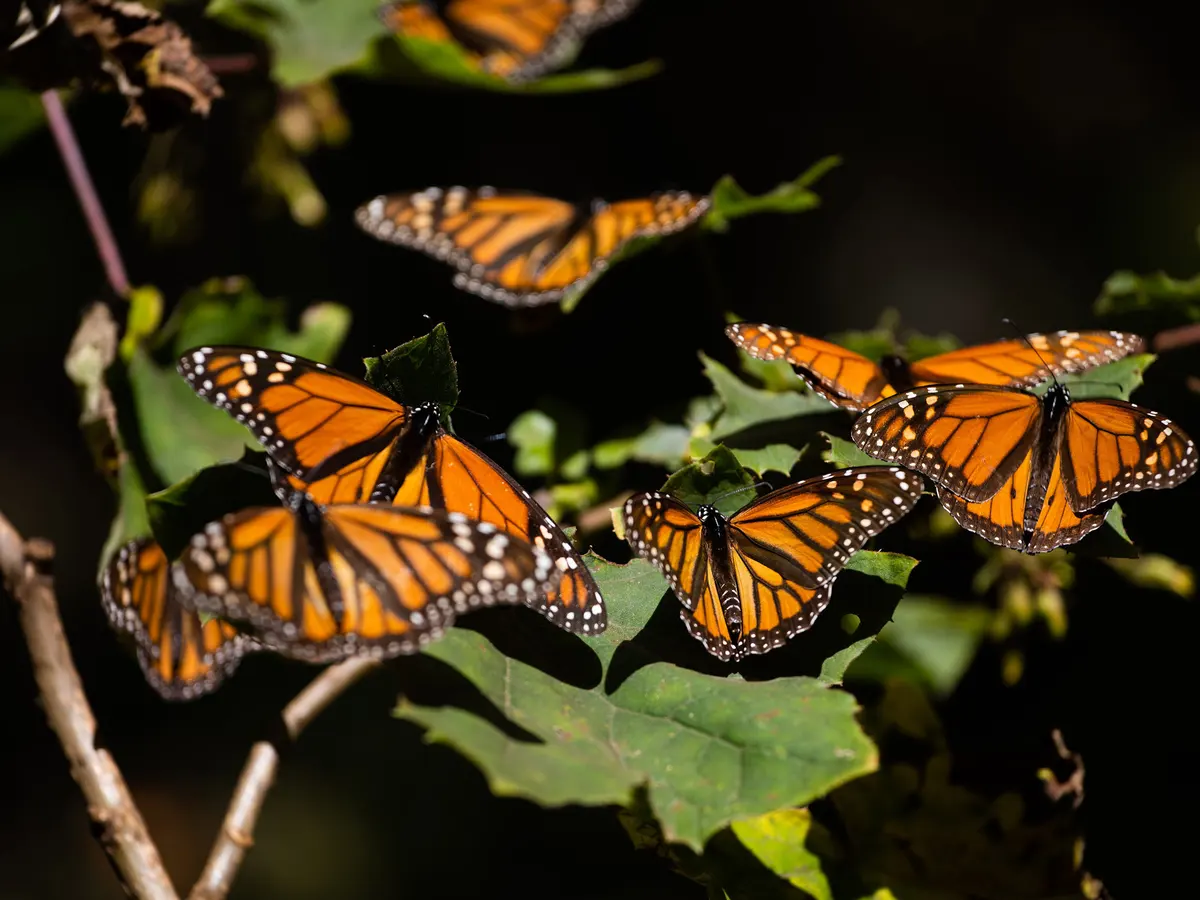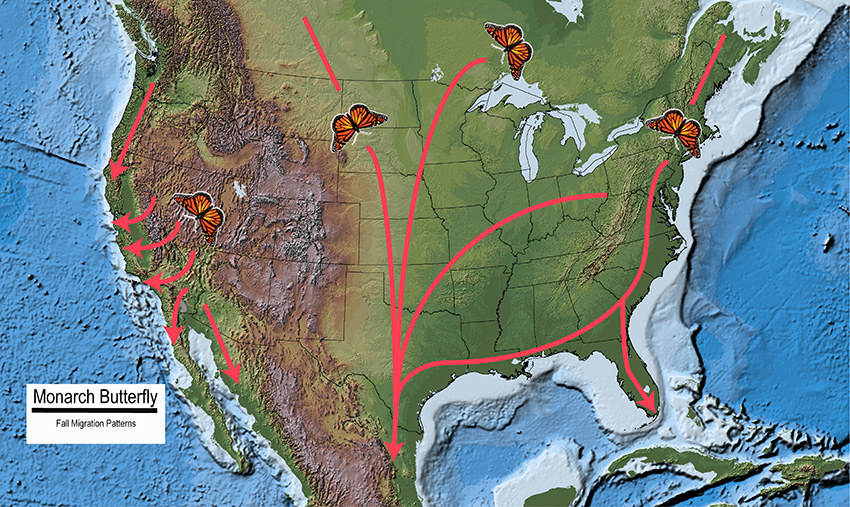Monarch butterfly

The Monarch butterfly (Danaus plexippus) is one of the most mesmerizing and enchanting creatures in the natural world. Its annual migration from Canada and the United States to the remote mountains of central Mexico has captivated the imagination of people around the world. Beyond its remarkable journey, the Monarch butterfly holds deep cultural and spiritual significance, particularly in Mexico, where it is often seen as a symbol of souls returning for Día de Muertos, the Day of the Dead.
About the Monarch butterfly
The Monarch butterfly is an insect that belongs to the order of Lepidoptera, a word whose Greek etymology comes from “lepis” (scale) and “pteron” (wing), defining this order as insects with scaly wings. They belong to the Danaidae family, and their scientific name is Danaus plexippus Linnaeus.
With great beauty and vibrant colors, Monarch butterflies are of vital importance in the cycle of life as pollinators and ecological balance factors in the forests they inhabit.
They stand out from their counterparts due to their longevity; while other butterflies have a lifespan of 24 days, Monarchs can live up to 9 months.
In turn, their wings feature a recognizable pattern of orange and black colors, with a wingspan of 8 to 12 cm, although there are basic differences between males and females:
a) Females have darker wings, and the black stripes on their wings are thicker.
b) Males, slightly larger, have thinner stripes compared to females, and a black spot can be seen on each of their hind wings, which release pheromones.

It is difficult to determine how many eggs female butterflies lay during their lifetimes, but it is estimated that the average in their natural habitat is probably between 300 and 400.
During their journey and stay in Mexico, adult specimens court and reproduce, giving rise to the generation that will fly to the United States and Canada in March; none of them will return to Mexico, as their lifespan is only a few weeks.
Monarch butterfly: life cycle
Like all their counterparts, Monarch butterflies take approximately a month to go through the stages of life:
1. Four days as an egg
2. Two weeks as a caterpillar
3. Ten days as a chrysalis
4. Up to 9 months as butterflies
Monarch butterfly: migratory routes
It is believed that Monarch butterflies migrate to Mexico because the country provides the appropriate conditions for them to spend the winter in the temperate forests of the central mountains, using various migratory routes:
1. Those that arrive in Mexico come from the area between the Rockies and the Great Lakes. They descend through the Eastern Sierra Madre and enter the Mexican Altiplano through the lower mountains, reaching the states of Mexico and Michoacán.
2. Others travel from the region located between the Pacific Ocean and the Rocky Mountains to the state of California.
3. Those inhabiting the area between the Atlantic Ocean and the Great Lakes cross the states of Carolina and Florida before reaching Cuba.

Monarch butterfly’s extraordinary migration
Each year, millions of Monarch butterflies embark on an awe-inspiring migration that spans thousands of miles. This incredible journey begins in North America, where the butterflies congregate and start their migration southward. They pass through several generations, each contributing to the next stage of the migration. The journey culminates in the Oyamel fir forests of central Mexico, where the butterflies seek refuge from the harsh winter conditions.
The Monarch’s migration is a testament to the marvels of nature’s navigation and survival instincts. The precise route and destination of this migration remain a scientific wonder, as these delicate insects manage to navigate across vast distances with astonishing accuracy.
Monarch butterfly’s symbolic significance
In Mexican culture, the Monarch butterfly holds deep symbolism that goes beyond its remarkable physical journey. It is believed to represent the souls of departed loved ones, who return to Earth during Día de Muertos, a traditional holiday celebrated on November 1st and 2nd. Día de Muertos is a time to honor and remember the deceased, welcoming their spirits back for a joyful reunion with the living.
The Monarch’s arrival in Mexico coincides with the Día de Muertos festivities, creating a profound connection between the natural world and the spiritual realm. The butterflies are seen as messengers, bringing with them the spirits of those who have passed away. Their vibrant orange and black colors are thought to resemble the marigold flowers, which are commonly used to create ofrendas (altars) to guide the souls back home.
Día de Muertos celebrations and the Monarch butterfly
During Día de Muertos, families across Mexico gather to celebrate the lives of their deceased loved ones. The celebrations are characterized by colorful decorations, marigold flowers, sugar skulls, and offerings of food, drinks, and mementos. Ofrendas are set up to honor the departed, featuring photographs, personal items, and favorite foods of the deceased.
The Monarch butterfly’s presence during this time adds an extra layer of symbolism to the festivities. Many believe that the butterflies are actual manifestations of the souls, providing a bridge between the earthly realm and the afterlife. The delicate creatures are said to carry messages of love, comfort, and reassurance from the beyond, helping families cope with their grief and offering a sense of connection with their departed relatives.
Conservation efforts and the Monarch butterfly
Despite its cultural significance and captivating migration, the Monarch butterfly faces numerous challenges in its survival. Habitat loss, climate change, pesticide use, and other factors have led to a decline in their population in recent years. Recognizing the importance of preserving this iconic species, various conservation efforts have been undertaken to protect the Monarch butterfly’s breeding grounds, migration routes, and winter sanctuaries.
Conservation initiatives also play a role in preserving the cultural traditions associated with the Monarch butterfly. By raising awareness about its symbolic significance during Día de Muertos, communities are motivated to support conservation efforts that not only protect the species but also ensure the continuation of a cherished cultural heritage.
The Monarch butterfly’s epic migration and its role as a symbolic messenger during Mexico’s Día de Muertos highlight the profound connections between nature, culture, and spirituality. As we marvel at the Monarch’s incredible journey, we are reminded of the delicate balance between the natural world and human traditions. By embracing both its scientific marvel and cultural significance, we can inspire greater efforts to conserve this enchanting species while honoring the timeless bonds between the living and the departed.
Where and when to see the Monarch butterfly?
Monarch butterflies cluster in the millions within the fir forests, the main type of vegetation in the core area of the Reserve, which represents the characteristic habitat of the Monarch butterfly.
The great traveler seeks the mountains of Michoacán and the State of Mexico, at an altitude of three thousand meters above sea level, because it is one of the regions in the world that provides them with special conditions for life during winter:
– Cool temperatures, which signal them to remain still to conserve energy and be able to return.
– Clouds and mist that provide them with water and humidity.
– Trees that protect them from hail and snow.
The sanctuary of the butterfly encompasses 70 percent of Michoacán territory and the remaining portion is in the state of Mexico. The main tourist-receiving sanctuaries are El Rosario in the municipality of Ocampo and Sierra Chincua in the municipality of Angangueo. This region is considered one of the four natural beauties recognized by UNESCO as World Heritage Sites in national territory.
This is how Monarch butterflies have made Mexico their second home. They feed on small plants known in the region as venenillo and algodoncillo, which, if not consumed, would cause an ecological imbalance in the pine and fir forests of Michoacán and the State of Mexico.
Monarchs first settle in fir or oyamel forests, which have a limited distribution and are sheltered from the wind, on slopes or in humid valleys located between 2,400 and 3,600 meters above sea level. The grouping of trees, 20 to 50 meters in height, with dense branches and needle-shaped leaves, creates a special microclimate. The intensity of light is low, temperature remains stable, humidity is high, and the wind moves slowly.
As the months pass, the colonies gradually move towards pine-oak forests, which are generally less dense.
Therefore, in order to protect the natural resources of the area and especially the phenomena of hibernation, reproduction, and migration of the Monarch butterfly, the observation activities of the Monarch butterflies can only be carried out in authorized sanctuaries and trails through authorized tourist service providers and guides who will be responsible for groups of no more than 20 people each.
The sanctuaries open to the public in the State of Mexico are El Capulín and Macheros Tourist Rest Stop and La Mesa Tourist Rest Stop, while in Michoacán, they include El Rosario Tourist Rest Stop, Sierra Chincua Cultural Center for Conservation, and Senguio Tourist Rest Stop.
In Mexico, the season for opening the sanctuaries and visiting for the observation of Monarch butterflies extends from November of each year to March of the following year.
The Monarch concludes its long migratory journey between late October and early November, arriving at its hibernation areas in Mexico. This has led to the ancient belief among the region’s inhabitants that each butterfly represents the soul of their departed loved ones, coming to visit them.
In order to conserve this migratory phenomenon, the Mexican government decreed the protection of Monarch butterfly colonies in 1980. In 1986, a protected area of 16,110 hectares was established, named the Monarch Butterfly Biosphere Reserve. In 2000, the total area of the Reserve was extended to 56,259 hectares.
Within the Reserve area, the Mexican Ministry of Environment and Natural Resources (Semarnat), through the Federal Environmental Protection Agency (Profepa), enforces the Zero Tolerance Program for Illegal Logging in the Monarch Butterfly Biosphere Reserve. This program reduced illicit deforestation from 243 hectares in 2007 to 0.4 hectares as of August 2011. The same mechanism is being applied in five other priority areas: Pico de Orizaba, Malinche, Izta-Popo, Valle de Bravo, and the Chichinautzin Biological Corridor.
Book the tour to see Monarch butterflies:
